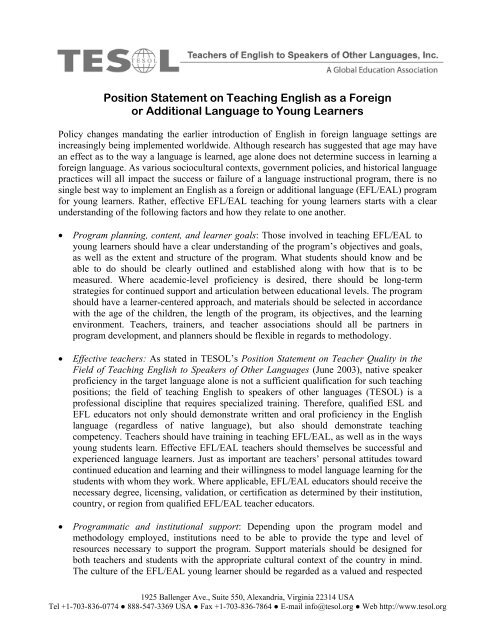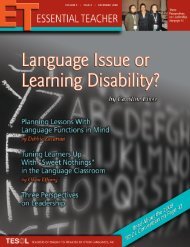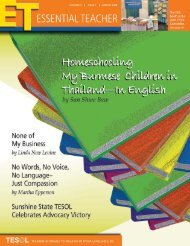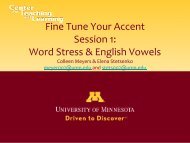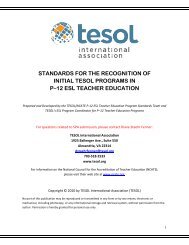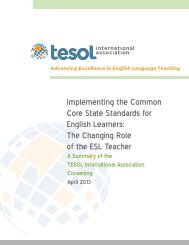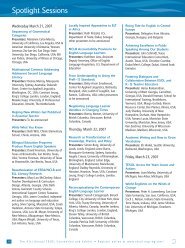Position Statement on Teaching English as a Foreign or ... - TESOL
Position Statement on Teaching English as a Foreign or ... - TESOL
Position Statement on Teaching English as a Foreign or ... - TESOL
Create successful ePaper yourself
Turn your PDF publications into a flip-book with our unique Google optimized e-Paper software.
<str<strong>on</strong>g>Positi<strong>on</strong></str<strong>on</strong>g> <str<strong>on</strong>g>Statement</str<strong>on</strong>g> <strong>on</strong> <strong>Teaching</strong> <strong>English</strong> <strong>as</strong> a <strong>F<strong>or</strong>eign</strong><br />
<strong>or</strong> Additi<strong>on</strong>al Language to Young Learners<br />
Policy changes mandating the earlier introducti<strong>on</strong> of <strong>English</strong> in f<strong>or</strong>eign language settings are<br />
incre<strong>as</strong>ingly being implemented w<strong>or</strong>ldwide. Although research h<strong>as</strong> suggested that age may have<br />
an effect <strong>as</strong> to the way a language is learned, age al<strong>on</strong>e does not determine success in learning a<br />
f<strong>or</strong>eign language. As various sociocultural c<strong>on</strong>texts, government policies, and hist<strong>or</strong>ical language<br />
practices will all impact the success <strong>or</strong> failure of a language instructi<strong>on</strong>al program, there is no<br />
single best way to implement an <strong>English</strong> <strong>as</strong> a f<strong>or</strong>eign <strong>or</strong> additi<strong>on</strong>al language (EFL/EAL) program<br />
f<strong>or</strong> young learners. Rather, effective EFL/EAL teaching f<strong>or</strong> young learners starts with a clear<br />
understanding of the following fact<strong>or</strong>s and how they relate to <strong>on</strong>e another.<br />
<br />
<br />
<br />
Program planning, c<strong>on</strong>tent, and learner goals: Those involved in teaching EFL/EAL to<br />
young learners should have a clear understanding of the program’s objectives and goals,<br />
<strong>as</strong> well <strong>as</strong> the extent and structure of the program. What students should know and be<br />
able to do should be clearly outlined and established al<strong>on</strong>g with how that is to be<br />
me<strong>as</strong>ured. Where academic-level proficiency is desired, there should be l<strong>on</strong>g-term<br />
strategies f<strong>or</strong> c<strong>on</strong>tinued supp<strong>or</strong>t and articulati<strong>on</strong> between educati<strong>on</strong>al levels. The program<br />
should have a learner-centered approach, and materials should be selected in acc<strong>or</strong>dance<br />
with the age of the children, the length of the program, its objectives, and the learning<br />
envir<strong>on</strong>ment. Teachers, trainers, and teacher <strong>as</strong>sociati<strong>on</strong>s should all be partners in<br />
program development, and planners should be flexible in regards to methodology.<br />
Effective teachers: As stated in <strong>TESOL</strong>’s <str<strong>on</strong>g>Positi<strong>on</strong></str<strong>on</strong>g> <str<strong>on</strong>g>Statement</str<strong>on</strong>g> <strong>on</strong> Teacher Quality in the<br />
Field of <strong>Teaching</strong> <strong>English</strong> to Speakers of Other Languages (June 2003), native speaker<br />
proficiency in the target language al<strong>on</strong>e is not a sufficient qualificati<strong>on</strong> f<strong>or</strong> such teaching<br />
positi<strong>on</strong>s; the field of teaching <strong>English</strong> to speakers of other languages (<strong>TESOL</strong>) is a<br />
professi<strong>on</strong>al discipline that requires specialized training. Theref<strong>or</strong>e, qualified ESL and<br />
EFL educat<strong>or</strong>s not <strong>on</strong>ly should dem<strong>on</strong>strate written and <strong>or</strong>al proficiency in the <strong>English</strong><br />
language (regardless of native language), but also should dem<strong>on</strong>strate teaching<br />
competency. Teachers should have training in teaching EFL/EAL, <strong>as</strong> well <strong>as</strong> in the ways<br />
young students learn. Effective EFL/EAL teachers should themselves be successful and<br />
experienced language learners. Just <strong>as</strong> imp<strong>or</strong>tant are teachers’ pers<strong>on</strong>al attitudes toward<br />
c<strong>on</strong>tinued educati<strong>on</strong> and learning and their willingness to model language learning f<strong>or</strong> the<br />
students with whom they w<strong>or</strong>k. Where applicable, EFL/EAL educat<strong>or</strong>s should receive the<br />
necessary degree, licensing, validati<strong>on</strong>, <strong>or</strong> certificati<strong>on</strong> <strong>as</strong> determined by their instituti<strong>on</strong>,<br />
country, <strong>or</strong> regi<strong>on</strong> from qualified EFL/EAL teacher educat<strong>or</strong>s.<br />
Programmatic and instituti<strong>on</strong>al supp<strong>or</strong>t: Depending up<strong>on</strong> the program model and<br />
methodology employed, instituti<strong>on</strong>s need to be able to provide the type and level of<br />
resources necessary to supp<strong>or</strong>t the program. Supp<strong>or</strong>t materials should be designed f<strong>or</strong><br />
both teachers and students with the appropriate cultural c<strong>on</strong>text of the country in mind.<br />
The culture of the EFL/EAL young learner should be regarded <strong>as</strong> a valued and respected<br />
1925 Ballenger Ave., Suite 550, Alexandria, Virginia 22314 USA<br />
Tel +1-703-836-0774 ● 888-547-3369 USA ● Fax +1-703-836-7864 ● E-mail info@tesol.<strong>or</strong>g ● Web http://www.tesol.<strong>or</strong>g
<str<strong>on</strong>g>Positi<strong>on</strong></str<strong>on</strong>g> <str<strong>on</strong>g>Statement</str<strong>on</strong>g> <strong>on</strong> <strong>Teaching</strong> <strong>English</strong> <strong>as</strong> a <strong>F<strong>or</strong>eign</strong> <strong>or</strong> Additi<strong>on</strong>al Language<br />
to Young Learners (c<strong>on</strong>tinued)<br />
resource that inf<strong>or</strong>ms decisi<strong>on</strong>s regarding approaches, techniques, activities, learning<br />
styles, curriculum design, and materials whether the young learner is in his/her native<br />
cultural setting <strong>or</strong> in a mixed-culture setting in a cl<strong>as</strong>sroom in a country where <strong>English</strong> is<br />
spoken <strong>as</strong> a native language. Instituti<strong>on</strong>s should provide resources f<strong>or</strong> young learners to<br />
be able to p<strong>or</strong>tray their cultural values within <strong>English</strong>-speaking c<strong>on</strong>texts, whenever<br />
possible, with the sole purpose of strengthening their own cultural identity at the same<br />
time <strong>as</strong> they are exposed to EFL/EAL learning experiences. Additi<strong>on</strong>ally, resource<br />
materials should be provided in sufficient quantities so that teachers can do their w<strong>or</strong>k<br />
well and productively. Community and home supp<strong>or</strong>t f<strong>or</strong> the program should be<br />
encouraged, <strong>as</strong> well <strong>as</strong> c<strong>on</strong>tinued professi<strong>on</strong>al development f<strong>or</strong> teachers, <strong>as</strong> it is an<br />
essential part of effective teaching.<br />
What is most imp<strong>or</strong>tant to understand about these fact<strong>or</strong>s is that they need to be defined f<strong>or</strong> and<br />
understood within the local educati<strong>on</strong>al and cultural c<strong>on</strong>text. In additi<strong>on</strong>, while the three fact<strong>or</strong>s<br />
are related, there is not necessarily a direct c<strong>or</strong>relati<strong>on</strong> am<strong>on</strong>g them. Just <strong>as</strong> there is no <strong>on</strong>e way<br />
to teach a language, there is no <strong>on</strong>e program <strong>or</strong> model f<strong>or</strong> all educati<strong>on</strong>al c<strong>on</strong>texts. Finding the<br />
right balance am<strong>on</strong>g these three fact<strong>or</strong>s is a key part of delivering an effective program.<br />
Resources<br />
Block, D., & Camer<strong>on</strong>, D. (Eds.). (2002). Globalizati<strong>on</strong> and language teaching. L<strong>on</strong>d<strong>on</strong>:<br />
Routledge.<br />
Camer<strong>on</strong>, L. (2001). <strong>Teaching</strong> languages to young learners. Cambridge: Cambridge University<br />
Press.<br />
Edelenbos, P., Johnst<strong>on</strong>e, R., & Kubanek, A. (2006). The main pedagogical principles<br />
underlying the teaching of language to very young learners. European Commissi<strong>on</strong>.<br />
Holliday, A. (1994). Appropriate methodology and social c<strong>on</strong>text. , Cambridge: Cambridge<br />
University Press.<br />
Holliday, A. (2005). Oxf<strong>or</strong>d applied linguistics: The struggle to teach <strong>English</strong> <strong>as</strong> an<br />
internati<strong>on</strong>al language.<br />
McCloskey, M. L., Orr, J., & Dolitsky, M. (Eds.). (2006). <strong>Teaching</strong> <strong>English</strong> <strong>as</strong> a f<strong>or</strong>eign<br />
language in primary school. Alexandria, VA: <strong>TESOL</strong>.<br />
Approved by the Board of Direct<strong>or</strong>s<br />
October 2003<br />
Revised October 2009<br />
2


